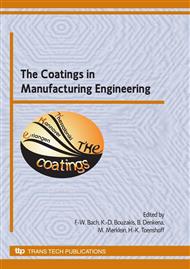[1]
K. Bobzin, N. Bagcivan, P. Immich, C. Pinero, N. Goebbels and A. Krämer: Werkstofftechnik Vol. 39, No. 1 (2008), pp.5-12.
DOI: 10.1002/mawe.200700252
Google Scholar
[2]
K. Bobzin, R. Nickel, P. Immich and S. Bolz: Proceedings of the 6th International Conference THE Coatings in Manufacturing Engineering, Hannover (2007), pp.119-126.
Google Scholar
[3]
K. Bobzin, J. Mayer, R. Nickel, P. Immich, A. Reinholdt and M. Ewering: Proceedings of the 6th International Conference THE Coatings in Manufacturing Engineering, Hannover (2007), pp.179-187.
Google Scholar
[4]
K. -D. Bouzakis, G. Skordaris, N. Michailidis, A. Asimakopoulos and G. Erkens: Proceedings of the 5th International Conference THE Coatings in Manufacturing Engineering, KallitheaChalkidiki (2005), pp.101-108.
Google Scholar
[5]
E. Uhlmann, T. Hühns, S. Grigoriev, W. Reimers and S. Dieter: Proceedings of the 5th International Conference THE Coatings in Manufacturing Engineering, Kallithea-Chalkidiki (2005), pp.417-423.
Google Scholar
[6]
H. K. Tönshoff, U. Stute, F. Otte, F. Meyer and S. Gollapudi: Proceedings of the 5th International Conference THE Coatings in Manufacturing Engineering, Kallithea-Chalkidiki (2005), pp.217-227.
Google Scholar
[7]
G. Fox-Rabinovich,J. L. Endrino, A. Kovalev, S. Veldhuis, F. Fontaine, B. Beake, L. Shuster and G. Dosbaeva: Proceedings of the 5th International Conference THE Coatings in Manufacturing Engineering, Kallithea-Chalkidiki (2005), pp.147-152.
Google Scholar
[8]
K. -D. Bouzakis, G. Skordaris, I. Misiridis, N. Michailidis, G. Mesomeris, E. Pavlidou and G. Erkens: Proceedings of the 5th International Conference THE Coatings in Manufacturing Engineering, Kallithea-Chalkidiki (2005), pp.109-118.
DOI: 10.1016/j.surfcoat.2005.08.015
Google Scholar
[9]
T. Friemuth: Herstellung spanender Werkzeuge (Postdoctoral Lecture Qualification, Universität Hannover 2002).
Google Scholar
[10]
B. Denkena and B. Breidenstein: Proceedings of the 6th International Conference THE Coatings in Manufacturing Engineering, Hannover (2007), pp.33-42.
Google Scholar
[11]
E. Macherauch and P. Müller: Zeitschrift für angewandte Physik Vol. 13 No. 7 (1961), p.305312.
Google Scholar
[12]
C. Genzel: Entwicklung eines Mess- und Auswerteverfahrens zur röntgenographischen Analyse des Eigenspannungszustandes im Oberflächenbereich vielkristalliner Werkstoffe (Postdoctoral Lecture Qualification, Humboldt-Universität Berlin 1999).
Google Scholar
[13]
B. Denkena, G. Erkens and B. Breidenstein: Materials Science Forum Vols. 638-642 (2010) pp.2383-2388.
Google Scholar
[14]
B. Denkena and B. Breidenstein: Proceedings of the 7th International Conference THE Coatings in Manufacturing Engineering, Kallithea-Chalkidiki (2008), pp.29-38.
Google Scholar


